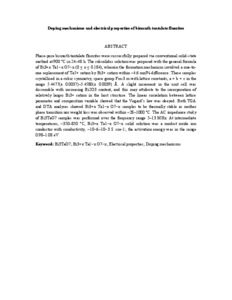Citation
Firman, Kartika and Tan, Kar Ban and Khaw, Chwin Chieh and Zainal, Zulkarnain and Tan, Yen Ping and Chen, Soo Kien
(2017)
Doping mechanisms and electrical properties of bismuth tantalate fluorites.
Journal of Materials Science, 52 (17).
pp. 10106-10118.
ISSN 0022-2461; ESSN: 1573-4803
Abstract
Phase-pure bismuth tantalate fluorites were successfully prepared via conventional solid-state method at 900 °C in 24–48 h. The subsolidus solution was proposed with the general formula of Bi3+x Ta1−x O7−x (0 ≤ x ≤ 0.184), wherein the formation mechanism involved a one-to-one replacement of Ta5+ cation by Bi3+ cation within ~4.6 mol% difference. These samples crystallised in a cubic symmetry, space group Fm-3 m with lattice constants, a = b = c in the range 5.4477(± 0.0037)–5.4580(± 0.0039) Å. A slight increment in the unit cell was discernible with increasing Bi2O3 content, and this may attribute to the incorporation of relatively larger Bi3+ cation in the host structure. The linear correlation between lattice parameter and composition variable showed that the Vegard’s law was obeyed. Both TGA and DTA analyses showed Bi3+x Ta1−x O7−x samples to be thermally stable as neither phase transition nor weight loss was observed within ~28–1000 °C. The AC impedance study of Bi3TaO7 samples was performed over the frequency range 5–13 MHz. At intermediate temperatures, ~350–850 °C, Bi3+x Ta1−x O7−x solid solution was a modest oxide ion conductor with conductivity, ~10−6–10−3 S cm−1; the activation energy was in the range 0.98–1.08 eV.
Download File
![[img]](http://psasir.upm.edu.my/13435/1.hassmallThumbnailVersion/Doping%20mechanisms%20and%20electrical%20properties%20of%20bismuth%20tantalate%20fluorites.pdf)  Preview |
|
Text (Abstract)
Doping mechanisms and electrical properties of bismuth tantalate fluorites.pdf
Download (1MB)
| Preview
|
|
Additional Metadata
Actions (login required)
 |
View Item |

